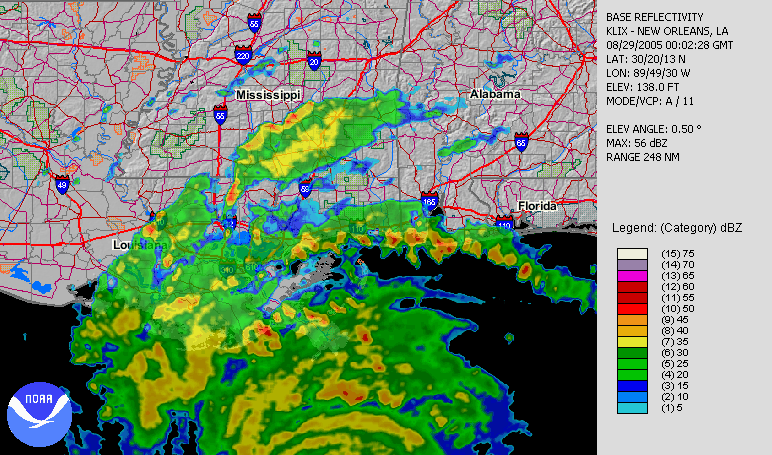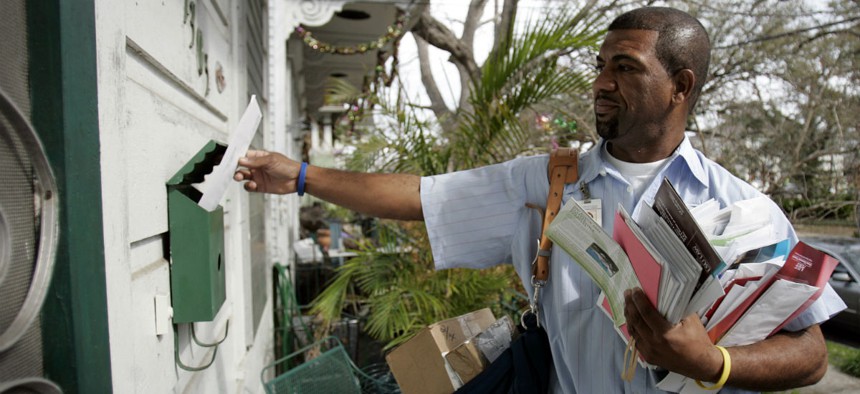How the Postal Service Managed a Remarkable Response During Katrina
Employees got work, mail was delivered and normalcy, eventually, was restored.
In the buildup and response to Hurricane Katrina, there is a lot the U.S. government got wrong.
At the local, state and federal level, agencies' actions were uncoordinated, resources were mismanaged and communication was severely deficient.
The U.S. Postal Service, however, avoided many of those pitfalls, navigating the disaster while delivering not just the mail, but a safety net to its displaced workforce and a sense of normalcy to a situation that so desperately needed one.
The Postal Service had a plan in place for disaster scenarios, and dealing with hurricanes was part of its “muscle memory,” according to Pat Mendonca, the senior director of the office of the postmaster tasked with overseeing USPS’ emergency preparedness. Before the storm's main landfall, the Postal Service moved vehicles to higher ground and topped them off with fuel, closed up collection boxes, updated employee emergency contact information and withheld mail bound for expected-to-be-impacted areas either at their point of origin or in Baton Rouge, La.
While most situations "are certainly not Katrinas," Mendonca told Government Executive, only preparedness enables people to adjust to developments on the ground.
“As much as you could prepare, those things went smoothly so you still had the ability to adjust to those things that revealed themselves,” Mendonca said.
Connecting With People
Postal management also made the decision before the storm hit to give any displaced employees a job wherever they landed -- some at processing plants, some at post offices and some even at the Washington, D.C. headquarters. It set up an 800 number for affected workers to call and tell the agency where they wound up. The agency, in coordination with postal unions, could then give them a job. In the months and years that followed, the Postal Service gave every displaced employee the opportunity to return to New Orleans if they wanted to do so.
In some cases, USPS was unable to track down an employee. It deployed the Postal Inspection Service to knock on doors and talk to neighbors, and eventually every worker was accounted for.
While coordinating that effort, the Postal Service faced another massive operational hurdle in storm-torn regions: delivering the mail.
USPS proactively reached out to customers, recalled Irene Lericos, USPS’ field communications manager who oversaw the agency’s communications efforts during Katrina. Through radio announcements and press releases, USPS assured customers that the Postal Service “would find them, locate their mail and get their mail sent to wherever they were.”
In New Orleans, postal officials spent “hours and hours” exclusively on the radio, Lericos said -- as the Times Picayune was not publishing and television stations were not up and running -- to explain how to notify the Postal Service of their whereabouts.

RELATED: An Oral History of the Katrina Response
The agency created a new change-of-address form specific to the situation, where individuals on the move could be sure address changes would be traced to their original addresses. Local postal officials made sure the forms were part of the in-processing at emergency shelters like the Astrodome in Houston.
“We put a lot of effort into keeping the mail moving with the people,” Mendonca said.
Through that process, and by coordinating with employees to ensure a sufficient workforce was available to carry out day-to-day duties, the Postal Service had the mail up and running before even basic services like electricity and running water were restored.
“The mail becomes such a critical component to a sense of normalcy, especially in catastrophic events like this,” Lericos said. She added the postal workforce understood and was motivated by that responsibility.
“Postal employees are so dedicated to their mission,” Lerico said. “I think they recognize their public service role, especially during crises.”
Lerico's deployed teams were working 20-hour days, so she created a rotational system to keep any employee from burning out. Mendonca also provided additional support to local managers, who were suffering their own life and property losses.
“We didn’t have trouble with managers showing up,” he said. “They showed up. But at the same time, they were suffering large losses.” New blood helped augment their efforts, Mendonca explained.
Interagency Collaboration
Seamless integration among federal agencies has long been a white whale of government, an idea that sounds nice in theory but consistently faces significant implementation obstacles, and never was that more true than during Katrina. The Postal Service, however, successfully assisted partners in delivering key services throughout the storm.
Before Katrina hit, USPS worked with the Social Security Administration to establish distribution centers for beneficiaries to receive their checks. Knowing it might not be able to deliver the checks immediately, the Postal Service publicized in advance of the storm where those hubs would be. While sales account managers worked with large mailers to delay delivery for some products, Social Security benefits were available without interruption.
The Federal Emergency Management Agency struggled after the storm to make individuals and families aware of the disaster benefits available to them. When radio and television stations went down, USPS coordinated with FEMA to deliver flyers to homes to explain how to take advantage of FEMA’s offerings.
The Postal Service -- with its continually updated change-of-address database -- also helped FEMA update its own database, and worked with the Justice Department’s National Center for Missing and Exploited Children to help families reunite with children. Postal communicators reached out to local officials to ensure a USPS official was present at every press conference they held.
After Katrina
Mendonca said the Postal Service applied many of the lessons it learned during Katrina to Hurricane Sandy. Lericos noted her job was made significantly easier during that storm, as the advent of social media made the distribution of new messages less burdensome.
The Postal Service undertakes disaster preparation every year, Mendonca said, so those things within the agency's control run smoothly. While Katrina may have been a 100-year storm, the next crisis for the Postal Service is never that far away.
“Because we use infrastructure -- the roads, power grid -- to do business,” Mendonca said, “we’re always affected in some fashion by anything that happens in United States. So we’re dealing on an ongoing basis with emergencies.”
While the next storm might look nothing like that last one, the Postal Service will -- like it did during Katrina -- “learn as the event goes.”








